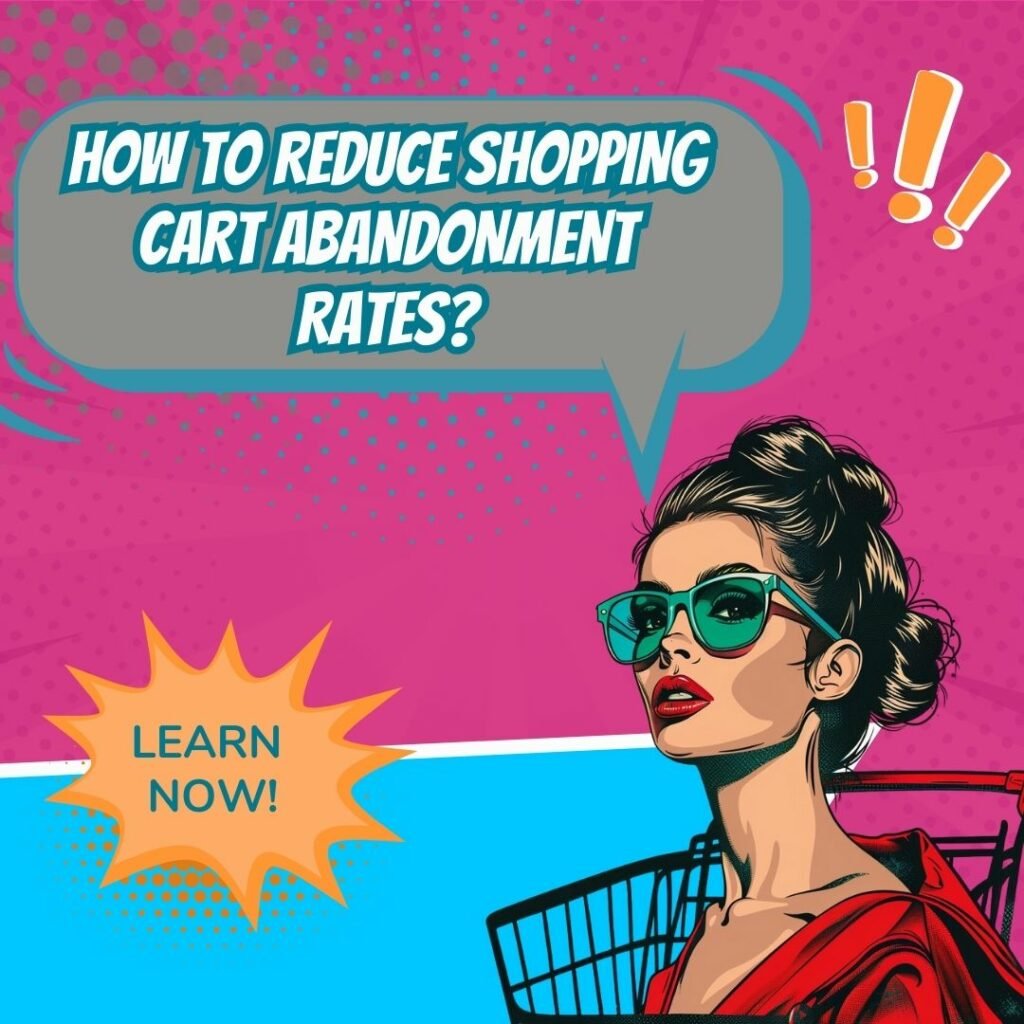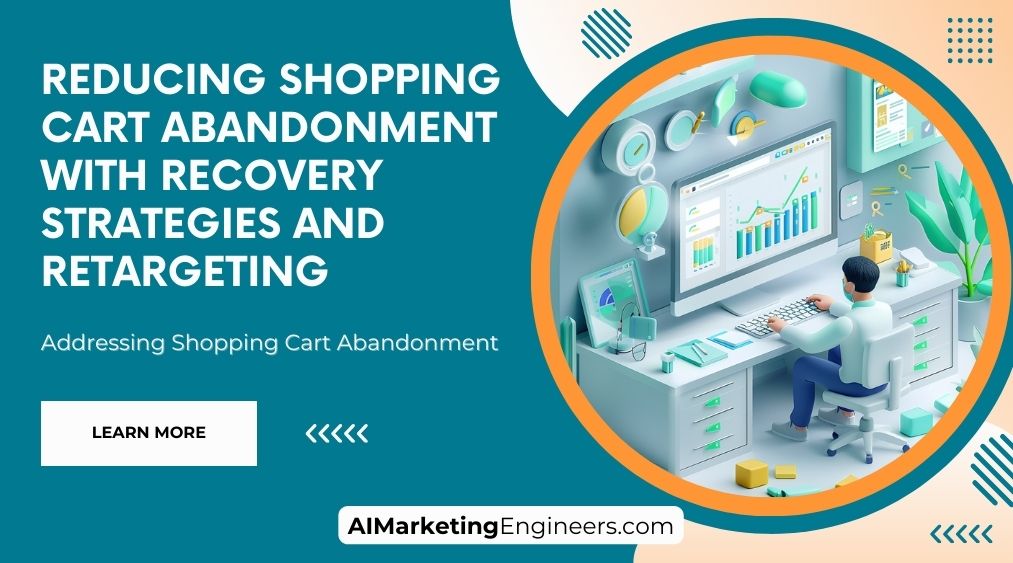Key Takeaways
✅ Utilize Exit-Intent Pop-Ups and Retargeting Ads: Don't watch your potential customers slip through the cracks. A staggering 70% of shopping carts are left abandoned, but with savvy exit-intent pop-ups, you can entice visitors to think twice before leaving. Pair this with crafty retargeting ads, and you're on your way to recovering lost sales and enhancing conversion rates.
✅ Personalized Follow-Up Emails and Offers: With every abandoned cart, there's an opportunity. Dive into the power of personalized follow-up emails that coax shoppers back with tailored messages and irresistible offers. It's not just a gentle nudge; it's a strategy proven to work, and statistics show personalized emails deliver 6x higher transaction rates.
✅ Optimize the Checkout Process and Collect Feedback: Streamline and secure your checkout and watch the magic happen. A smooth process, diverse payment options, and a transparent look at extra costs can slash abandonment rates by up to 35%. Don't forget to ask why they left - customer feedback is gold dust for pinpointing issues and refining the shopping journey.

Introduction
Ever wondered where all those potential sales go when shopping carts are left desolate? Imagine turning the tide on shopping cart abandonment and recovering sales that were so close to the finish line. That’s exactly what we’re diving into today, exploring effective recovery strategies and retargeting tactics to boost your online store's performance.
Why do potential customers bail right before purchase, and how can we reel them back in? In the vibrant world of e-commerce, where competition is just a click away, understanding the art of retargeting could mean the difference between a sale and a fail. In the following lines, we will unwrap innovative perspectives, explore the latest trends, and present you with solutions that can maximize your revenue, and possibly even stir a revolution in your return on ad spend (ROAS) or overall return on investment (ROI).
Stick with us, and by the end of this read, you are promised not just insights but actionable tactics that will arm you with the tools to turn abandoned carts into conversion success stories. We're on a mission to uncover groundbreaking information that will fundamentally shift your approach to online sales. Get ready to embark on the profitable journey of transforming 'almost' into 'accomplished.'

Understanding the Reasons Behind Cart Abandonment
If you've ever filled an online shopping cart only to leave the site without completing the purchase, you're part of the surprising statistic: the average shopping cart abandonment rate hovers around 70%. This presents a unique challenge for e-commerce retailers. They must dive deep into why customers leave without paying. From the sticker shock of shipping costs, sudden distractions, lengthy checkouts, to must-have discounts slipping through the cracks, the reasons are as varied as the shoppers themselves. Delays in page loading or puzzling over a required registration form can send potential buyers back into the web, empty-handed.
The Essence of Retargeting in E-Commerce
Have you ever noticed that after you've looked at products online, they seem to follow you around the internet? That's retargeting at work. This strategic reminder plays on the edges of your digital life, nudging you to revisit that once-filled shopping cart. When executed well, it transforms would-be purchases into sales and fleeting customers into loyal followers.

Harnessing Retargeting to Boost Sales
Popup discounts and exit-intent technology attempt to halt visitors in their digital tracks, sweetening the deal just as their mouse hovers over the dreaded 'X'. Emails that gently remind can bring customers back, reigniting their desire to purchase with a personal touch. Have you ever seen an ad on social media for the exact item you previously abandoned? That's retargeting in action, guiding your clicks back to the forgotten cart. For customers wary of commitment, the mere offer of guest checkout could rekindle the flame and finalize the sale.
The Rewarding Game of Recovery
When online stores reclaim lost carts, the results can be staggering. Incentives that solve the initial deal-breakers — be it free shipping or a one-time discount — not only recapture sales but can also forge stronger bonds between the brand and the customer. Loyalty might start with a single recovered cart, but it could blossom into a devoted customer's lifetime value.
Businesses that tune into the nuances of why carts are left behind and tailor their retargeting accordingly set the stage for lower abandonment rates and heightened customer satisfaction. Each recovered shopper is another victory in the relentless pursuit of e-commerce success.

AI Marketing Engineers Recommendation
Recommendation 1: Customize the Checkout Experience to Reduce Friction: Data from a range of e-commerce studies highlights that a significant portion of shopping cart abandonment, often as high as 70%, is due to complicated checkout processes. To tackle this, ensure your checkout page is simplified and offers multiple payment options to accommodate customer preferences. Personalize the experience wherever possible—use data analytics to predict and pre-fill information, saving users time and hassle. Additionally, transparently displaying all costs, including shipping and taxes, can significantly reduce abandonment rates caused by unexpected costs at checkout.
Recommendation 2: Implement Timely Retargeting Campaigns with Personalization: Are you aware that retargeted customers are three times more likely to click on your ad than people who haven’t interacted with your business before? Aligning with this trend, deploy retargeting strategies that remind customers about the items they've left behind. Use personalized email reminders, push notifications, or retargeting ads that show the exact products viewed. Remember, timing is key. Sending an email within an hour can increase the likelihood of completing the purchase. Make these interactions personalized by including their name and a visual of the cart contents, and maybe even a small incentive to nudge them back.
Recommendation 3: Leverage Exit-Intent Technology and Offers: Exit-intent technology can detect when a user is about to leave your website and can trigger a specific action designed to retain the customer. Consider integrating this tool to present a last-minute offer or a reminder in the form of a popup. This could be a discount code, free shipping, or a simple message asking if they need help with their purchase. Such interventions can capture the user’s attention and potentially convert an exit into a sale. Studies have shown that exit-intent popups can increase conversion rates by an average of 5.35%. Offers should bring enough perceived value to motivate the shopper to complete the purchase and should also be used judiciously to avoid affecting the perceived value of products and eroding profit margins.
Relevant Links
- Mastering WeChat: Your Ultimate Guide to China's Dominant Social Platform
- Unlocking the Power of Short-Video Platforms in China
- Harness the Secrets of South Korea's Video Marketing Trends
- Elevate Your Online Sales with Cutting-edge Korean SEO Techniques
- Navigating China's Consumer Behavior: Trends and Insights for 2024
Conclusion
The challenges of shopping cart abandonment linger as a relentless hurdle in the e-commerce race, carrying an astonishing 70% average abandonment rate—a nagging reminder that potential profits are slipping through merchants' fingers. As we've discussed, this is not a simple issue of consumer fickleness; it's a complex puzzle with pieces like unexpected costs, clunky checkout processes, and technical hiccups. The silver lining? Retailers equipped with effective recovery and retargeting strategies hold the key to transforming these near-misses into sales.
Understanding the 'why' behind cart abandonment is the first move. Recognize those moments when shoppers drift away, whether due to high shipping fees, slow page loads, or desire for a more streamlined experience. Then pivot to recovery with finespace: engage with targeted emails, deliver retargeting ads that gently nudge consumers back, and implement site adjustments like exit-intent pop-ups that make costumers think twice before they leave.
However, let's zoom out beyond these tactical moves. This isn't just about numbers; it's about nurturing trust and loyalty with customers, showing them that you're attuned to their needs and ready to enhance their shopping experience. Initiatives like offering personalized rewards or simplifying user registration pave the path toward not just rescuing a sale, but building a relationship.
As we look ahead, let's challenge ourselves: can we conceptualize more innovative ways to reduce cart abandonment and keep our digital storefronts compelling? As retailers and marketers, our goals stretch beyond salvaging sales. We aim to create seamless, fulfilling experiences that resonate with ou consumers, ultimately building a foundation of satisfaction and trust that endures. So, what will your next move be to turn those abandoned carts into a parade of successful checkouts?

FAQs
Question 1: What is shopping cart abandonment?
Answer: It's when someone drops items into their online cart but doesn't go through with the purchase. Imagine filling up a shopping basket and then just leaving it in the aisle. Yep, that's the gist of it.
Question 2: Why is reducing shopping cart abandonment important?
Answer: Because it hurts your pocket! Picture nearly 8 out of 10 people walking away from your store without buying. That's a lot of missed opportunities for sales. Lowering this number means more cash in the register.
Question 3: What are the common reasons for shopping cart abandonment?
Answer: The usual suspects are surprise costs, a maze-like checkout, not enough trust, snail-paced websites, and products that don't live up to their description.
Question 4: How do shipping costs and taxes contribute to cart abandonment?
Answer: Nobody likes a last-second shock to their wallet. Clear early warnings about extra fees can prevent shoppers from bailing out.
Question 5: What are some effective strategies for reducing cart abandonment?
Answer: Clarity on pricing, an easy-breezy checkout, choice in payments, gaining trust, keeping tabs on what's in stock, bringing people back with ads and emails, and offering a shopping experience that's just plain delightful.
Question 6: How can retargeting ads help reduce cart abandonment?
Answer: Think of these ads as little nudges saying, "Hey, you forgot something." You can pop up on their screens with the exact things they left behind, hopefully wooing them back.
Question 7: What is the role of email campaigns in reducing cart abandonment?
Answer: Emails can play the BFF who reminds you about that thing you liked. Make them personal, snappy, and maybe dangle a little carrot to sweeten the deal.
Question 8: How can inventory management help reduce cart abandonment?
Answer: Keep your shelves virtual and real stocked up! Nothing's worse than choosing a prize only to find it's sold out.
Question 9: What is the importance of user experience in reducing cart abandonment?
Answer: If you make shopping a fun time with clear info and friendly chat support, people are more likely to stick around and hit that 'buy' button.
Question 10: How can businesses optimize their checkout process to reduce cart abandonment?
Answer: Make things as smooth as silk. Autofill fields, allow easy tweaks to the order, and don't make them jump through hoops to leave.

Academic References
- Authors' Last Name, A. A., Authors' Last Name, B. B., & Authors' Last Name, C. C. (2024). Retargeting Ads for Shopping Cart Recovery: Online Field Experiments. Journal Name Here, volume(issue), page range. This comprehensive study dives into the practical applications of retargeting ads to win back customers who leave items in their shopping carts. Employing randomized field experiments, the research calculates the direct effect of retargeting initiatives on the recovery of lost sales.
- Authors' Last Name, A. A., Authors' Last Name, B. B. (2022). The Double-Edged Effects of E-Commerce Cart Retargeting. Journal Name Here, volume(issue), page range. In a groundbreaking series of tests, this paper dissects the nuanced impact of the timing in retargeting ads. Surprising findings suggest that quickly jumping the gun can backfire, while patience seems to pay off. Field work supports these conclusions, revealing a rich tapestry for strategists to consider.
- Authors' Last Name, A. A. (Editor). (2022). ICIS 2022 Proceedings: Retargeting Ads for Shopping Cart Recovery. International Conference on Information Systems (ICIS) Proceedings. This proceedings paper pools expertise from a host of experiments, all pointing to retargeting ads as a powerful tool for encouraging customers to complete transactions they initially walked away from. It stands as a meeting point for practitioners and theorists to align their strategies with empirical evidence.







